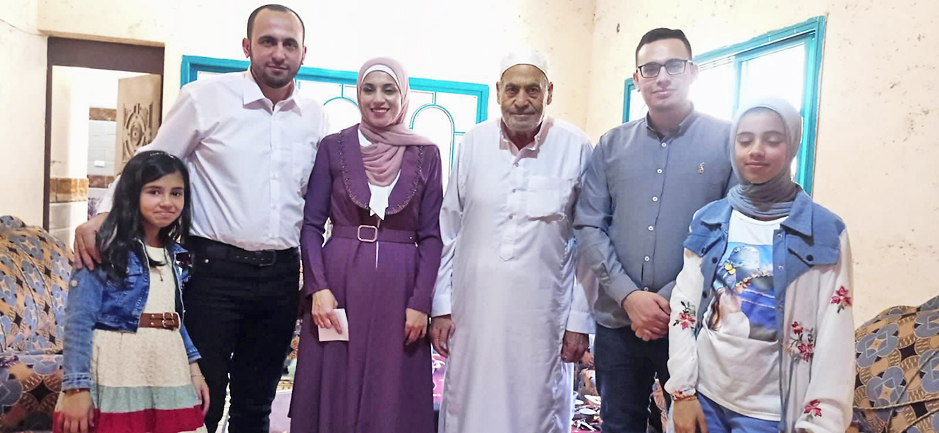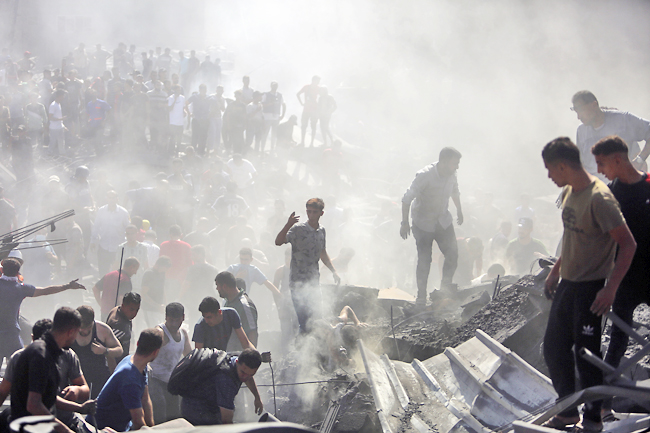AP – The night a blast struck his family’s home in the Gaza Strip, Ahmed al-Naouq was more than 2,000 miles away but he still jolted awake, consumed with inexplicable panic.
He reached for his mobile phone to find that a friend had written – and then deleted – a message. Al-Naouq called him from London. The words that spilled from the other end of the line landed like world-shattering blows: Airstrike. Everyone killed.
Four nights later, Ammar al-Butta was startled from sleep in the southern Gaza city of Khan Younis when the wall of his bedroom collapsed over him. A missile had pierced his top-floor apartment and exploded one floor below.
He lurched over the rubble, shining the light of his cellphone into the wreckage, calling out to his 16 relatives.
“Anyone there?” he cried. There was only silence.
Entire generations of Palestinian families in the besieged Gaza Strip – from great-grandparents to infants only weeks old – have been killed in airstrikes in the Israel-Hamas war, in which the Israeli army said it aims to root out the group from the densely populated coastal territory.
Attacks are occurring at a scale never seen in years of Israel-Hamas conflict, hitting residential areas, schools, hospitals, mosques and churches, even striking areas in southern Gaza where Israeli forces ordered civilians to flee.





Israel said the goal of the war is to destroy Hamas following the group’s deadly October 7 rampage in southern Israel that killed at least 1,200 people, and it maintains that the attacks target militant operatives and infrastructure.
It blames the high death toll – more than 11,000 people, according to the Gaza Health Ministry – on Hamas, saying the group endangers civilians by operating among the population and in tunnels underneath civilian areas. Israel said the death toll includes Hamas fighters.
But the scope of the destruction and loss of life in Gaza, with entire families wiped out in a single strike, has raised troubling questions about Israeli military tactics.
GENERATIONS LOST
It would take many hours of horror and mayhem before the truth would settle like the ash from the October 20 explosion that levelled al-Naouq’s family’s home: 21 relatives killed.
They included his 75-year-old father, two brothers, three sisters and their 13 children.
“I can’t believe this actually happened,” graduate student in London al-Naouq told The Associated Press. “Because if I calculate what it means, I will be destroyed.”
His father, Nasri, had recently told him that his sister Aya’s home was destroyed in northern Gaza and she was staying with them in the central city of Deir al-Balah, south of the area Israel had ordered Palestinians to leave.
A home can be rebuilt, al-Naouq recalled replying, all that matters is that she and the children are alive.
But just hours later, they were all dead: Wala’a, the most accomplished of the al-Naouq children with a degree in engineering, and her four children; Alaa and her five children; Aya, known for her wry sense of humour, and her three children; older brother Muhammed; and younger brother Mahmoud, who was preparing to travel to Australia for graduate studies when the war broke out.
Nine of the 21 are still under the rubble; dire fuel shortages prevented civil defence crews from digging them out.
Identifying the dead was another traumatising endeavour; many bodies were unrecognisable, most were in pieces.
Al-Naouq’s sister Doaa who was not in the house at the time of the strike, told him she couldn’t bear the smell of the rotting flesh of their loved ones under the rubble. Someone showed her body parts retrieved from the site and told her it was one of their sisters.
There were two survivors: al-Naouq’s sister-in-law Shimaa and his three-year-old nephew Omar. His 11-year-old niece, Malaka, was taken to al-Aqsa hospital with severe burns but died after doctors gave her ICU bed to another patient with a better chance of survival, his sister Doaa said.
Doctors have to make extraordinarily difficult triage decisions, and severely wounded patients are being left to die because of shortages of beds, medical supplies and fuel, said Dr Mohammed Qandeel in Nasser Hospital, Gaza’s second largest.
“We leave most as we don’t have ventilators or beds,” he said of patients in need of intensive care with complicated blast wounds. “We’ve reached full collapse.”
COMPETING CLAIMS
Israel doesn’t say how it chooses targets in densely populated Gaza. But Israeli officials say many strikes on homes are based on intelligence assessments that wanted Hamas operatives are inside. Though it gives few details, Israel said every airstrike is reviewed by legal experts to ensure they comply with international law.
Many Gaza families deny any Hamas targets were operating from their homes.
The health ministry in Hamas-run Gaza does not distinguish between civilians and combatants, but said a majority of Palestinians killed have been minors and women, about 4,500 and 2,200 respectively. – Samya Kullab & Najib Jobain






